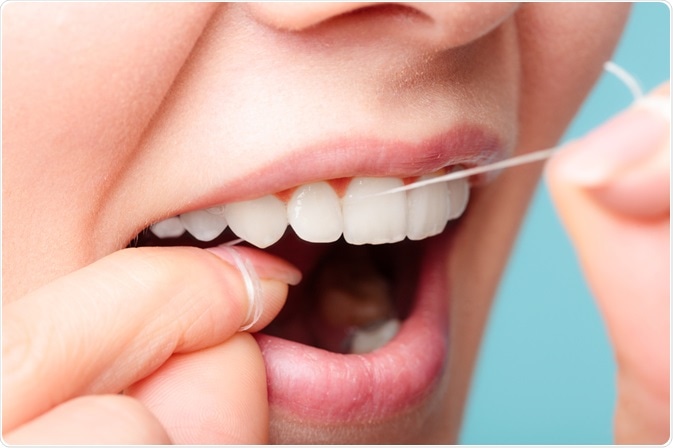Maintaining good oral hygiene is one of the most crucial aspects of good dental health. Tooth brushing and dental flossing are recognized as one of the most widely recommended methods for maintaining healthy gums and teeth.

Image Credit: Voyagerix/Shutterstock.com
Tooth flossing is routinely advised by dental practitioners; however, less is known about the recommended flossing technique.
Why is tooth flossing recommended?
The oral cavity provides an ideal environment for housing various bacteria. As soon as food is consumed these bacteria combine with food particles resulting in the formation of plaque. Plaque if not removed, can slowly accumulate in between the tooth spaces in the form of hard deposits referred to as tartar.
Both plaque and tartar result in dental concerns like inflammation of gums resulting in gum ailments like gingivitis and periodontitis. Plaque entrapped between teeth is a host of various dental issues like:
- Tooth decay known as tooth caries leads to decay of the tooth structure
- Gingivitis referred to as swelling of the gums thereby causing bleeding from the gums
- Periodontitis which causes the damage of structures supporting teeth such as ligaments and bone
- An overall decline in oral health which can manifest in various symptoms like pus formation, tenderness, and inability to masticate food
- Deranged dental health not only contributes to the above mentioned oral conditions but can also lead to severe medical conditions including cardiac disease and even preterm labor.
Tooth flossing is specifically recommended to such individuals who have a tight interdental (space between two adjoining teeth) spacing especially because there is an increased risk of entrapment of food particles which does not easily go away by rinsing or tooth brushing.
What is the right age to start tooth flossing?
Tooth flossing is recommended soon after the permanent dentition replaces the milk teeth. Children can start flossing teeth once they reach an age of 12 years; however, it is imperative to seek advice from a dental practitioner primarily to understand the right technique.
Children can also use interproxa brushes instead of dental floss as they are considered a good substitute. Various facts play a role in promoting flossing habits in children; however, one study was conducted to understand the predictors of dental health in school-going children.
The results showed that a supportive family environment plays a crucial oral in encouraging children towards dental flossing.
Flossing is recommended among all age groups ranging from children to older age groups. One such study was done to assess the effects of flossing on the elderly population. The results indicated that subjects who included flossing in their daily regimen experienced better oral health.
The analysis was based on an observation for 5 years supported the fact that flossing in the elderly can prevent many oral diseases like caries, gingivitis, and periodontitis.

Image Credit: Jacob Lund/Shutterstock.com
What is the right technique for flossing?
According to the American Dental Association, tooth flossing is recommended at least once a day. Below is a series of sequential steps which one can follow:
- Tear off at least 18 inches of floss and wrap it around one of the middle fingers. Wrap the rest of the portion of floss around the finger of the opposite hand. Floss wrapped on the opposite finger will retain the food particles removed during the process
- Tightly hold the floss between thumbs and your fingers and then gently direct the floss towards the teeth using a gentle rubbing motion but make sure not to push the floss directly into the gums.
- Once the floss is at the gum line turn the floss around the neck of the tooth to make a C shaped curve. Move the floss slowly into the area between the gums and the teeth
- Floss should be retained at a position firmly against the tooth and then smoothly start rubbing the floss gently against the tooth and start sliding the floss away from the gum in an upside and downward motion.
- Follow the same steps for each tooth not leaving aside the backside of even the last tooth of both upper and lower arches.
- Discard the floss after completing the above procedures. Never reuse the floss once it is used as reusing the same floss may reintroduce the bacteria in the gums
Which is the most appropriate floss?
There is a wide range of dental products available in the market including a variety of dental floss. However, it is recommended to buy floss that bears the seal of the American Dental Association, primarily because it is marketed only once as it holds the acceptance of safety and efficacy.
Researchers are trying to introduce a variety of dental flosses primarily to make flossing more effective during the routine dental cleaning process. One such recent study revealed that dental floss soaked with povidone-iodine solution enhances the antibacterial capacity of floss.
Dental floss saturated the povidone-iodine solution has the antibacterial potency and thus exhibits an excellent therapeutic property in aiding good dental health.
Further Reading